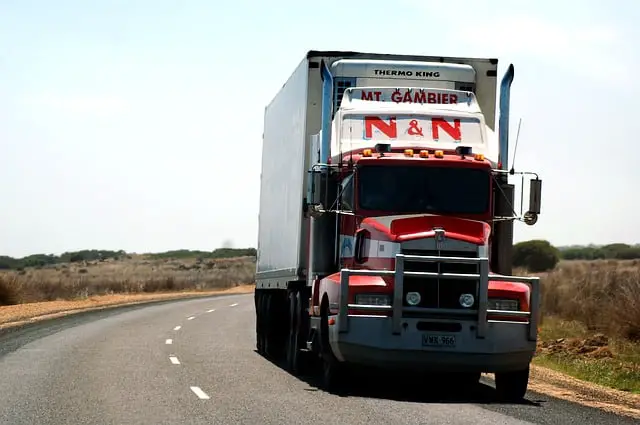All new jobs can be stressful and bring on new challenges that you are not always prepared for. This is especially true when your job involves operating an 80,000-pound semi-truck.
No one wants to look like a newbie by making embarrassing mistakes the first time on the road. That is why we have compiled a list of the most common errors new truck drivers make so you can avoid the ridicule and look like a pro behind the wheel.
Mistake #1- Not Accounting for Truck Size
New truck drivers tend to forget they are not in their normal everyday vehicle anymore. You can’t operate a 50-foot long, 14- foot high truck the same way you drive your Camaro, Silverado or Civic.
 New drivers should account for size especially when making turns. Turns should be taken slowly and surroundings should be accounted for. This can be especially true when having to maneuver through a residential area. If you are delivering in a big city, these areas can be packed with parked cars lining the streets.
New drivers should account for size especially when making turns. Turns should be taken slowly and surroundings should be accounted for. This can be especially true when having to maneuver through a residential area. If you are delivering in a big city, these areas can be packed with parked cars lining the streets.
If you are in a tight area with no little room to move, take your time and get out of your truck and observe the area. Not long ago, I ripped off the bumper of a car because it was illegally parked. It wasn’t until after I had worked to clear the turn for a few minutes that I realized my trailer had grabbed the bumper of the car. Fortunately, I wasn’t ticketed as it was the car’s fault for parking where they shouldn’t have.
I still wish I had taken a minute to get out of my truck and walk around it before trying to get out of the area. It would have saved me some paper work and a headache. Another example of how our mirrors don’t come close to showing us everything we need to see.
Another example of not taking into account the size of the truck happened to my buddy when he was starting out. Most rookie drivers focus all their attention on the size of the truck BEHIND them. They forget about the area in front of them which is especially important when backing up. When backing into a tight spot, you have to remind yourself to keep an eye on the front of your truck. My buddy wasn’t paying attention when backing in to pick up a load and the front bumper of his truck clipped the car of a Vice President for the company he was picking up from.
Another thing to keep an eye out for regarding the size of your truck is when going through roundabouts or 360 on-ramps. This is especially true when you are going through old towns up in the New England area. Many times the roundabouts were built to have the wide turns needed for a truck to make it through without taking all the signs, shrubs, and poles with it that are in the middle of the circle. If you come upon one of these, you may have to improvise to figure a way through it that will create the least amount of damage.
Obviously, not much is more embarrassing than hitting a bridge or low ceiling because your truck was too tall. ALWAYS watch out for ‘Low Clearance’ signs. Know the height of the truck you are driving and be ready to find a different route when you’re not going to fit.
Mistake #2 – Losing focus on the details
I’m not sure this falls into the “rookie” mistake category. Odds are you will make this mistake at some point in your career. I wanted to put it on here, because it can be a costly mistake. Forgetting to put your gas cap on after refueling is something I’ve done a couple times. The worst was when I drove for a couple hours and lost a decent amount of fuel because it was sloshing out of the tank opening. Not only are you out quite a few gallons of diesel, but you have to pick up a new cap as well.
The road gets boring, and many times we are low on sleep and stressed about making our delivery. Try to get yourself in the habit of making mental checks when you stop just to avoid unnecessary problems and issues.
Mistake #3 – Merging Too Slowly or Too Quickly
Merging on the highway or dodging other vehicles can also be a cause of stress for new drivers. Speeding up takes more time in an 18-wheeler, so make sure you have enough room while getting on the highway and always know ahead of time when your exit is coming up to avoid moving over three or four lanes at the last minute.
Other vehicles merging onto the highway can be just as tricky. Watch out for on ramps and adjust accordingly. Some drivers want to move over as soon as they see cars approaching from the on ramp. To avoid being the newbie that changes lanes every five seconds just slow down or maintain your speed. Most cars will be faster than you anyway and will speed up to merge before you are even close.
As a general rule of thumb, seasoned truck drivers will stay in the center lane when there is a lot of merging traffic or if they are travelling close to the speed limit. If the traffic is lighter or their speed is regulated they tend to stick to the right lane. A tick to keep in mind is if you are getting passed on both sides you are in the wrong lane.
Mistake #4 – Neglecting Personal Care
Truck driving is not your typical 9-5 job. It takes some adjusting to the schedule of driving for long hours and sometimes through the night. New drivers should be very aware of when they are too tired to keep driving and when they should take a break.
 Many new drivers will continue driving through their exhaustion to stay on schedule but this could be a dangerous mistake. If you start to feel sleepy behind the wheel don’t be afraid to pull over at a rest stop to stretch your legs or grab some coffee to keep you focused. Even taking a short nap can make a big difference if necessary.
Many new drivers will continue driving through their exhaustion to stay on schedule but this could be a dangerous mistake. If you start to feel sleepy behind the wheel don’t be afraid to pull over at a rest stop to stretch your legs or grab some coffee to keep you focused. Even taking a short nap can make a big difference if necessary.
Make sure to stay hydrated on the road as well and always have something to listen to while you make long trips. Music and podcasts can be a lifesaver when you start getting bored on the road.
Mistake #5- Not Planning Ahead for Food
Constantly being on the road makes it difficult to maintain healthy eating habits. It’s easy to pull off the road at a McDonald’s three times a day, and typically this seems like the fastest, most accessible option when you are first starting out in the truck-driving profession. However, this can be avoided by simply planning ahead.
Experienced drivers plan for their long day of driving by packing meals to take on the road. Meal prep gives you more healthy options and is also a much cheaper option. It is also better for truck drivers to have about 4-5 smaller meals during their day, rather than 3 big meals. This will keep you focused so you are never running on completely empty. Also, you won’t fall into the dreaded food coma after consuming a big meal. That could be dangerous and lead to drowsiness while driving.
If you don’t have the time, or energy, to prep meals in advance, grocery stores usually offer healthy grab-n-go options. These are just as quick as fast food and give you more variety with fresh fruits and vegetables and hot food options as well. Some drivers worry about finding truck-friendly parking lots, but most stores provide specific areas for this purpose. The spots may be a little farther away but that gives you the added bonus of a little bit of exercise!
Mistake #6 – Put Eyes on the Load
This is a tip that will save you some time and embarrassment. Always put an eye on the load before you drive away. What I mean by this, is that you need to look at the product in your truck before closing the doors and locking it up. I have heard of numerous instances where a driver has hooked up to the wrong trailer and sometimes driven hundreds of miles before realizing they had the wrong load. This is extremely embarrassing, but also a costly mistake as you’ll have to return the shipment to its original destination. Take the extra few minutes and glance inside your trailer before driving away.
Mistake #7- Ignoring Safe Practices
There are many other factors to consider before hitting the road on your first truck-driving trip, in addition to the driving in general. Your vehicle is now your office and you must make sure everything is in line and ready to go. Inspections can be tedious and some new drivers may speed through it to get on the road quicker. But, it is especially important to be thorough so there are no surprise emergencies.
Driving newbies should check tire pressure AT LEAST once a month and also check load tie-downs before the start of every trip. Another common oversight is the organization and cleanliness of your cab. Loose trash and unnecessary junk in your vehicle can get jammed under your gas or brake pedal or could become projectiles if you happen to be in an accident. Always make sure things are stowed away in the glove box or a secure compartment and have important papers or other objects within reach just in case.
Drivers are required to carry an emergency kit in their vehicle at all times. Also, make sure all lights and reflectors are working properly and not blocked by dirt and other road debris. It’s easy to overlook a lot of the little details while you are inspecting your vehicle. But, a few extra minutes before your trip could save you hours of headache on the road.
Mistake #8 – Getting Stuck
One thing that sometimes catches a new driver by surprise is how easy it is to get a truck stuck. I’ve seen drivers just barely get off the pavement with their steers (front wheels) and into some mud no more than a few inches deep. If you are empty or bobtailing, odds are you will need to call a tow truck to pull you out unless you are lucky and at a location where someone has a front loader available.
Mistake #9- Setting Unrealistic Expectations
Some new drivers come into the job with a picture in their head of making loads of money and picking perfect jobs and hours right out of the gate. Truck driving can be a great profession and provides many benefits, BUT like in any other job, you have to work your way up and create a reputation for yourself first.
 Sometimes the routes won’t be great and the hours may be long and arbitrary. New drivers won’t get to pick their first choice in driving assignments and may be sent to undesirable locations. Also, sometimes drivers don’t consider the variable conditions such as traffic and weather that will inevitably delay some trips.
Sometimes the routes won’t be great and the hours may be long and arbitrary. New drivers won’t get to pick their first choice in driving assignments and may be sent to undesirable locations. Also, sometimes drivers don’t consider the variable conditions such as traffic and weather that will inevitably delay some trips.
Despite a couple downfalls the job can be very rewarding. Veteran truck drivers can receive generous compensation and benefits. However, rookie drivers should not expect to be making big money right away. This common misconception can affect retention levels.
Although your first driving job may not be exactly what you had thought, it is very important to stick with it for a year or two. This will show future employers that you can stick with a job and proves your loyalty. Also, starting a job at a different company would most likely be very similar and switching could just delay your career growth.
Rookie to Veteran in No Time
Everybody has to start somewhere. Truck drivers who have been driving for 40 years got into the cab for the first time at some point. There are bound to be some slip-ups and many things have to be learned as you go.
For the time being, don’t go into the truck-driving life with too much confidence. Always be willing to learn from your peers and don’t get discouraged when you receive constructive criticism from a veteran.
Best of luck to you!
